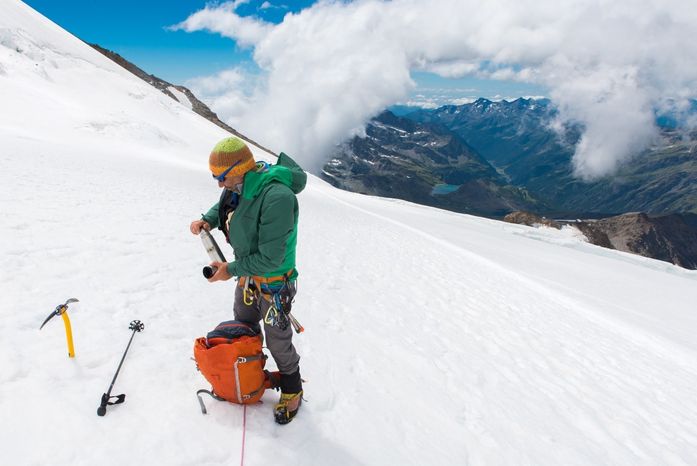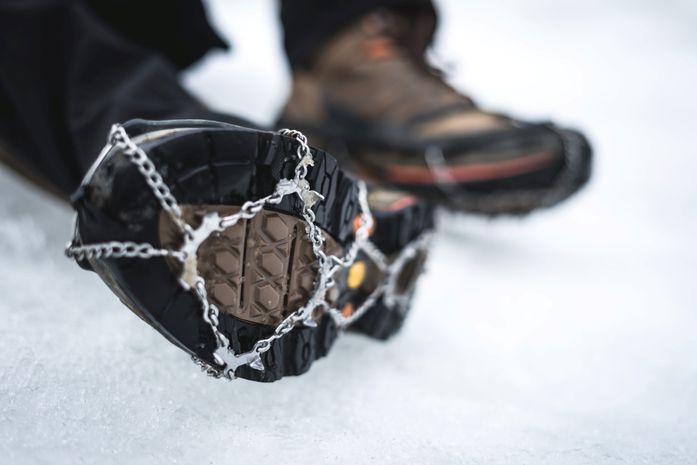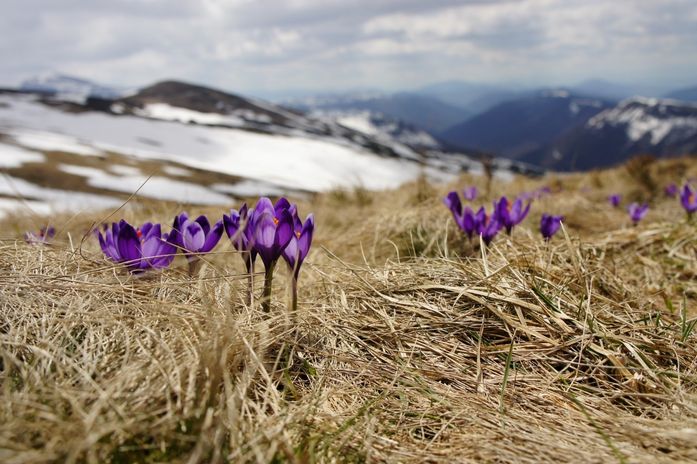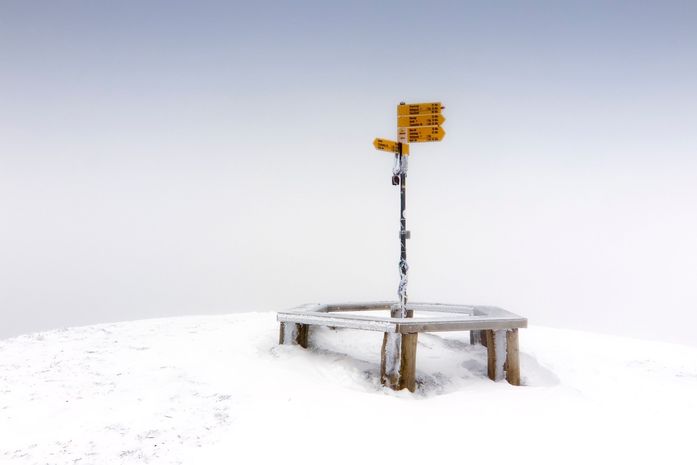Winter is over, spring is slowly creeping in, and you must be hiking as soon as yesterday. This guide will give tips on crossing a spring snowfield without endangering your life. Adventure is fun, but safety is of more importance. The good thing is you can still enjoy your hiking adventure and stay safe.

While hiking, you will notice that snow in some areas remains intact despite winter being long gone. These are the regions we identify as snowfields, and they pose a considerable risk to hikers. Snow can be unpredictable because what you see on the surface differs from what is happening underneath.
Most people tend to be more cautious when hiking and camping in winter because they are already aware of the looming risks; hence the reported incidents are few. We cannot say the same for snowfields since several serious accidents are reported annually. Hikers let down their guards when they feel there is a lower likelihood of getting into an accident.
However, it would help if you were more careful when hiking across a snow field in spring because you stand a higher chance of getting into an ugly incident.
What you will need when hiking across a spring snowfield

Whether a hiking beginner or a guru, you must understand your route to prepare appropriately. This guide on how to cross a Spring Snow field provides a list of items you must pack once you realize that you will encounter a snowfield along your route. This is besides all the other supplies that you need for your hiking adventure, and they are as follows:
Ice axe
You need to have an ice axe when moving across steep snowy terrains to help you self-arrest in case you start slipping downhill. You should have it on your hands once you encounter the snowy patch since an incident might occur, and you will not have the time to reach out for your backpack. If you are a beginner, gather enough information on using the ice axe from experienced hikers and reliable online sources.
Appropriate shoes
You need to have the right shoes when crossing a spring snow field. We highly recommend winter hiking boots which you can carry as an extra in the backpack and put on when approaching the snow field.
Winter shoes have an advantage over ordinary hiking shoes because they provide a grip on the ice and minimize the chances of slipping and falling. Winter shoes are also waterproof. You cannot afford to have wet feet while hiking as you risk injuries such as chafing and blisters. The resulting pain is unbearable.
Crampons and Microspikes

You can have crampons and microspikes as an alternative to winter boots or as an extra safety measure. With crampons, you can wear your favorite pair of hiking shoes but make sure they are waterproof. You can put on the Crampons or micro spikes once you approach a snowfield and get them off as soon as you are done crossing.
The main difference between crampons and microspikes is that microspikes are shorter spikes and are suitable for walking on thin ice, while crampons have longer spikes suitable for thick ice and snow slabs.
Trekking Pole
Snowfields challenge hikers because it is more challenging to walk on snow than on bare ground. There is resistance and danger of slipping on the snowfields. To counter the resistance and make crossing the spring snow field easier, you should carry a trekking pole with you.
The main task of a trekking pole is to provide stability so that you walk for a long distance without using too much energy. Your joints can get worked up as you try to maneuver the snowy path leading to exhaustion even before you are done crossing the snowfield.
Hikers prefer having two trekking poles on each hand, but this can only be practical if you are on a flat surface where you will not need an ice axe.
Essential Tips on How to Cross a spring snowfield

Tip 1: Walk Across and not around the snowfield
As you approach a snowfield, you may be tempted to go around it and avoid walking on the snow. This might not be the best decision because it will take you longer. You cannot be sure that the ground next to the snowfield is stable enough that you will walk at your average pace. It can be muddy, slippery, or even too rocky.
In the case of slippery ground, you can slip, fall and get an injury that will impede you from going on with your journey. It is, therefore, safer to walk across the snowfield with the right tools and information on how to stay safe.
The other reason why you are better off maintaining the snowfield route is that you might not see beyond some obstacles; you do not have a way of knowing whether you will still get to your destination when you go around the snowfield. The path could lead you to a different place, and you will lose your trail.
Getting back on track will eat into your time, and chances are you will still return to the snowfield.
Tip 2: Look Out for the Hazard Signs

Most hiking trails have well-placed signage that you should pay attention to. On the snowfield, there will be a sign indicating transition zones, where hikers fall most of the time. The terrain changes drastically, and it isn’t easy to know since the snow cover portrays a consistent landscape.
To be safe on the snowfield, you should be on the lookout for hazard signs and make sure you understand the warning. Look way ahead of you to avoid surprises and get the time to prepare to encounter the dangers.
You might need to put on your crampons, clench on the trekking pole or even get out the ice axe as you approach a sloping terrain. It is safer to get ready prior because it might be too late too soon.
Tip 3: Keep your Technical Tools close
Depending on the terrain ahead, you may need tools such as the ice axe at hand. Trekking poles on both hands make climbing more effortless, but they might not be helpful when you start gliding downhill. It can help to maintain one trekking pole and have an ice axe on the other hand.
By the time you are hitting the trail, you are already aware that you will encounter a snowfield along the route. It would be best to consider this when packing your bag and put the necessary tools where you can easily reach them. You do not want to unpack an entire bag looking for crampons or an ice axe because you have got the snowfield and now need to use them.
Tip 4: Proper timing might be your lifesaver

As you prepare your hiking schedule, you should consider the fact that you will cross a snowfield at some point. A spring snowfield is an interesting phenomenon since the snow does not thaw despite the warmth of summer and spring.
Avalanches are a common sight on the snow fields, and they mainly occur when the snow beneath thaws and an entire mass of snow start to move. It can cause serious injuries or even end up in fatalities.
To prevent such hazards, you should plan your journey in a way that you will cross the snowfields in the early mornings when the ice is still firm. While at it, avoid areas with boulders since the rocks will absorb heat and melt the ice underneath them. Be keen enough to notice any slight shift in the snow.
Tip 5: Keep kicking as you go
The best way to walk through a snowfield is by kicking. As complex as it may sound, it will help you move faster instead of taking steps. Kicking, in simple terms, is displacing the snow as you move.
Step kicking is more practical when ascending because it creates a level ground to keep the balance. This technique is convenient when crossing a snowfield but can also be tiring. If you are hiking in a group, you can take turns whereby one person takes the lead and does the kicking while the rest follow the trail, and then you switch positions after a certain distance.
Kicking when descending is different; you step on the heel first, then the rest of the foot follows. This exercise helps you to maintain balance as you go downhill faster.
Conclusion
Our primary goal is to help you enjoy the trails by arming you with information and lifesaving tips. If the snowfield looks impassable, you can always reroute and enjoy a different trail. You should be careful not to put your life in danger. Call for help if you get trapped or injured in the snowfield.
We look forward to reading your comments about this guide. Talk to us in the comment section.
Show your appreciation by liking and sharing the post!
